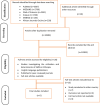Electronic Medical Record System Use and Determinants in Ethiopia: Systematic Review and Meta-Analysis
- PMID: 36630161
- PMCID: PMC9878362
- DOI: 10.2196/40721
Electronic Medical Record System Use and Determinants in Ethiopia: Systematic Review and Meta-Analysis
Abstract
Background: The strategic plan of the Ethiopian Ministry of Health recommends an electronic medical record (EMR) system to enhance health care delivery and streamline data systems. However, only a few exhaustive systematic reviews and meta-analyses have been conducted on the degree of EMR use in Ethiopia and the factors influencing success. This will emphasize the factors that make EMR effective and increase awareness of its widespread use among future implementers in Ethiopia.
Objective: This study aims to determine the pooled estimate of EMR use and success determinants among health professionals in Ethiopia.
Methods: We developed a protocol and searched PubMed, Web of Sciences, African Journals OnLine, Embase, MEDLINE, and Scopus to identify relevant studies. To assess the quality of each included study, we used the Joanna Briggs Institute quality assessment tool using 9 criteria. The applicable data were extracted using Microsoft Excel 2019, and the data were then analyzed using Stata software (version 11; StataCorp). The presence of total heterogeneity across included studies was calculated using the index of heterogeneity I2 statistics. The pooled size of EMR use was estimated using a random effect model with a 95% CI.
Results: After reviewing 11,026 research papers, 5 papers with a combined total of 2439 health workers were included in the evaluation and meta-analysis. The pooled estimate of EMR usage in Ethiopia was 51.85% (95% CI 37.14%-66.55%). The subgroup study found that the northern Ethiopian region had the greatest EMR utilization rate (58.75%) and that higher (54.99%) utilization was also seen in publications published after 2016. Age groups <30 years, access to an EMR manual, EMR-related training, and managerial support were identified factors associated with EMR use among health workers.
Conclusions: The use of EMR systems in Ethiopia is relatively low. Belonging to a young age group, accessing an EMR manual, receiving EMR-related training, and managerial support were identified as factors associated with EMR use among health workers. As a result, to increase the use of EMRs by health care providers, it is essential to provide management support and an EMR training program and make the EMR manual accessible to health professionals.
Keywords: EHR; EMR; Ethiopia; determinants; electronic health record; electronic medical record system; health information technology; health professional; medical record; systematic review; utilization.
©Masresha Derese Tegegne, Sisay Maru Wubante, Mulugeta Hayelom Kalayou, Mequannent Sharew Melaku, Binyam Tilahun, Tesfahun Melese Yilma, Hiwote Simane Dessie. Originally published in the Interactive Journal of Medical Research (https://www.i-jmr.org/), 11.01.2023.
Conflict of interest statement
Conflicts of Interest: None declared.
Figures







Similar articles
-
User Satisfaction of Using Electronic Medical Record System and Its Associated Factors among Healthcare Professionals in Ethiopia: A Cross-Sectional Study.Biomed Res Int. 2023 Apr 17;2023:4148211. doi: 10.1155/2023/4148211. eCollection 2023. Biomed Res Int. 2023. PMID: 37101688 Free PMC article.
-
Barriers to the Adoption of Electronic Medical Record System in Ethiopia: A Systematic Review.J Multidiscip Healthc. 2021 Sep 17;14:2597-2603. doi: 10.2147/JMDH.S327539. eCollection 2021. J Multidiscip Healthc. 2021. PMID: 34556994 Free PMC article. Review.
-
Electronic medical record use and associated factors among healthcare professionals at public health facilities in Dire Dawa, eastern Ethiopia: A mixed-method study.Front Digit Health. 2022 Aug 23;4:935945. doi: 10.3389/fdgth.2022.935945. eCollection 2022. Front Digit Health. 2022. PMID: 36440461 Free PMC article.
-
The prevalence of respectful maternity care during childbirth and its determinants in Ethiopia: A systematic review and meta-analysis.PLoS One. 2022 Nov 23;17(11):e0277889. doi: 10.1371/journal.pone.0277889. eCollection 2022. PLoS One. 2022. PMID: 36417397 Free PMC article.
-
Health Professionals' Readiness and Its Associated Factors to Implement Electronic Medical Record System in Four Selected Primary Hospitals in Ethiopia.Adv Med Educ Pract. 2020 Feb 21;11:147-154. doi: 10.2147/AMEP.S233368. eCollection 2020. Adv Med Educ Pract. 2020. PMID: 32110135 Free PMC article.
Cited by
-
Exploring facilitators and barriers of the sustainable acceptance of e-health system solutions in Ethiopia: A systematic review.PLoS One. 2023 Aug 10;18(8):e0287991. doi: 10.1371/journal.pone.0287991. eCollection 2023. PLoS One. 2023. PMID: 37561684 Free PMC article.
-
Analyzing health service employees' intention to use e-health systems in southwest Ethiopia: using UTAUT-2 model.BMC Health Serv Res. 2024 Sep 27;24(1):1136. doi: 10.1186/s12913-024-11567-y. BMC Health Serv Res. 2024. PMID: 39334209 Free PMC article.
-
Barriers and facilitators to utilizing digital health technologies by healthcare professionals.NPJ Digit Med. 2023 Sep 18;6(1):161. doi: 10.1038/s41746-023-00899-4. NPJ Digit Med. 2023. PMID: 37723240 Free PMC article. Review.
-
Barriers and facilitators of the electronic medical record adoption among healthcare providers in Addis Ababa, Ethiopia.Digit Health. 2024 Dec 10;10:20552076241301946. doi: 10.1177/20552076241301946. eCollection 2024 Jan-Dec. Digit Health. 2024. PMID: 39659403 Free PMC article.
-
The Effects of Electronic Health Records on Medical Error Reduction: Extension of the DeLone and McLean Information System Success Model.JMIR Med Inform. 2024 Oct 16;12:e54572. doi: 10.2196/54572. JMIR Med Inform. 2024. PMID: 39412857 Free PMC article.
References
-
- Dutta B, Hwang Hsin-Ginn. The adoption of electronic medical record by physicians: a PRISMA-compliant systematic review. Medicine (Baltimore) 2020 Feb;99(8):e19290. doi: 10.1097/MD.0000000000019290. https://europepmc.org/abstract/MED/32080145 00005792-202002210-00075 - DOI - PMC - PubMed
-
- Ariffin NABN, Ismail AB, Kadir IKA, Kamal JIA. IJARPED. 2018 Aug 06;7(3):187–199. doi: 10.6007/ijarped/v7-i3/4358. - DOI
-
- Tegegne MD, Melaku MS, Shimie AW, Hunegnaw DD, Legese MG, Ejigu TA, Mengestie ND, Zemene W, Zeleke T, Chanie AF. Health professionals' knowledge and attitude towards patient confidentiality and associated factors in a resource-limited setting: a cross-sectional study. BMC Med Ethics. 2022 Mar 14;23(1):26. doi: 10.1186/s12910-022-00765-0. https://bmcmedethics.biomedcentral.com/articles/10.1186/s12910-022-00765-0 10.1186/s12910-022-00765-0 - DOI - DOI - PMC - PubMed
Publication types
LinkOut - more resources
Full Text Sources
Research Materials

